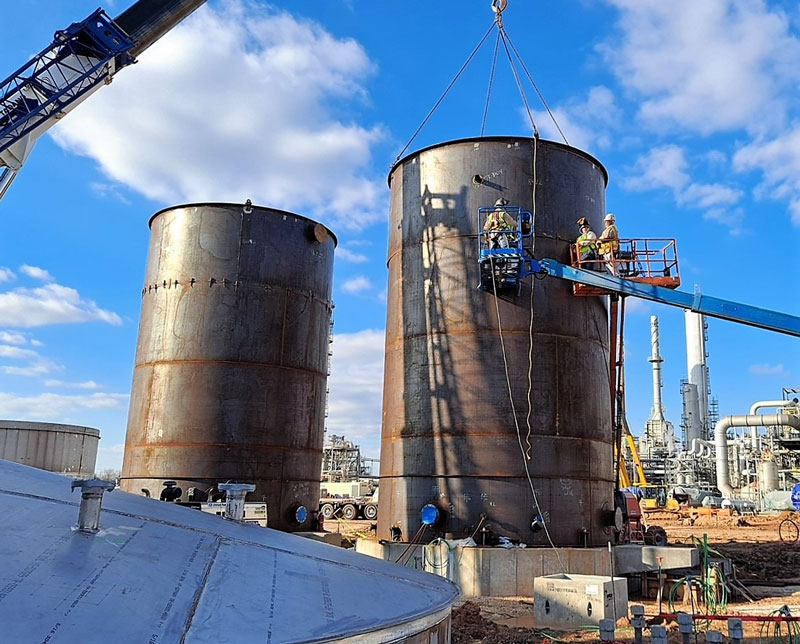Fuel storage is a critical component of nearly every industrial enterprise, and it’s a complex one. Fuels can be flammable, combustible, and pressurized, as well as potentially pose health or environmental hazards. Regulation of fuel storage is necessarily stringent.
What this means is that well-functioning, well-maintained, and long-lasting fuel storage tanks are key to meeting regulatory requirements and maximizing your cost efficiency. Keep reading to learn the average life expectancy of aboveground fuel storage tanks, as well as how to ensure the optimal lifespan of your fuel storage tanks.
Average Life Expectancy of Aboveground Fuel Storage Tanks
On average, the life expectancy of aboveground fuel storage tanks and other aboveground storage tanks (ASTs) is about 20 years. This can vary based on the fabrication and materials, application, features, location, size, and maintenance of the storage tank. As you might expect, poorly maintained tanks may not last for 20 years, and well-maintained tanks may remain serviceable beyond this period.
Why the Life Expectancy of Your Aboveground Fuel Storage Tanks Matters to Your Facility
Fuel is essential to your operations, and so are the aboveground fuel tanks in which you store it. It’s crucial to maintain your storage tanks at their highest level of function to ensure smooth and efficient operations and to save money.
Planning, designing, and constructing aboveground tanks for fuel storage is not an inexpensive endeavor, nor is it quickly accomplished. It also carries a significant regulatory burden to ensure that tanks meet the appropriate API standards. To maximize cost efficiency, it’s important that you optimize the lifespan of your fuel storage tanks.
Knowing the expected lifetime of your fuel ASTs is also extremely useful for planning for the future and phasing outdated, poorly functioning equipment before a tank failure or before the cost of sub-optimal operation and extensive repairs and maintenance outpace the replacement cost of the fuel tank. Replacing a storage tank that experiences an unexpected catastrophic failure is a huge hit to your budget—for the replacement tank and mitigating any negative consequences. But the planned, budgeted-for replacement of an aging fuel storage tank won’t result in the same dent to your bottom line.
How to Achieve Optimal Life Expectancy for Aboveground Fuel Storage Tanks
Regular Inspections of Fuel Storage Tanks
Regular inspections are critical to keeping tanks in good repair and operating efficiently. If a stitch in time can save nine, an inspection is what informs you that the stitch is necessary, in time, before it causes noticeable problems for your operations.
Aboveground storage tank repairs and inspections must meet API Standard 653. This standard requires that the facility’s aboveground storage tank arrangement plan (TAP) be inspected and reassessed every five years, or when changes are made that affect the TAP. For ASTs with pressure vessels, inspections must also address compliance to API Standard 510.
Additionally, the aboveground tanks themselves should be inspected monthly, at minimum.
Tank inspections should assess:
- Tank structure
- Foundation
- Containment
- Insulation
- Electrical equipment
ASTs are prone to corrosion and weather damage, being above ground and exposed to the elements; this kind of damage can cause leaks, contamination, and myriad other issues that, if not addressed in time, can require extensive clean-up and repairs.
Older tanks that are nearing the end of their life expectancy should be assessed for their continued serviceability, tracking maintenance costs and operating costs. Tanks that require increasing maintenance, with increasing maintenance costs, may need to be reconstructed or phased out of use.
Aboveground Fuel Storage Tank Maintenance and Repairs
In every industry, facility, and application, in-use equipment will require regular maintenance and repairs, even under ideal operating conditions. This is especially true for equipment like aboveground fuel storage tanks, which have electrical equipment, may be pressurized, and can contain fuels that are considered hazardous substances.
Again, maintenance and repairs of ASTs must meet API Standard 653. Necessary maintenance can include liner installation, firewall repair, decommissioning, repairs to tank body or other components, and repairs or changes to internal and external piping. For pressurized fuel storage tanks, maintenance and repairs may also be needed for pressure vessels and spheres, in adherence with ASME Section VIII.
While you may be able to handle some of these maintenance activities in-house, it’s vital to have a relationship with a contractor who specializes in API- and ASME-compliant aboveground fuel storage tank maintenance and repair. This can help control costs and reduce tank downtime. PALA can include 3D Laser Scanning technology with inspections and repair to ensure you’re getting the accurate data you need to make the right decisions for your aboveground storage tanks.
With decades of experience in industrial fabrication, PALA can handle every element of design, fabrication, delivery, or even just on-site repairs, ensuring your facility gets a long-lasting aboveground storage tank that performs according to your application’s requirements. For more information about our services and capabilities, get in touch with our team today.

